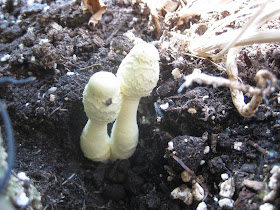So we're off to a good start, although I see nothing yet from the two Red Fire chili pods, which is the one I'm most interested in (I do a lot of Asian cooking). Hope I won't have to get a replacement for the replacement :P
A day-to-day diary reporting on my experiences with my indoor garden, dedicated to gardeners like me who's been relegated to apartment and office living and seeks to exercise an itchy green thumb.
Thursday, September 15, 2011
Wednesday, September 7, 2011
Chili, Take Two
I recently went to the fabulous Brooklyn Botanical Garden. Being an indoor garden nut, every time I go to a botanical garden, I always try to seek out the herb garden.
Brooklyn's herb garden is phenomenal. One of the highlights is a huge patch of chili peppers. The variety of pepper seemed exactly the same as my erstwhile Aerogarden peppers, down the the shapes of the leaves. Difference, of course, is that there were a LOT of peppers.
This inspired me to get off my keister and replant those four Aerogarden pods once and for all. Again, taking the lessons learned from the last batch, I'm hoping that my indoor gardening experience this time goes a little better.
The first step was doing another thorough cleaning of the unit. One of the tricky things about Aerogardens is that cleaning is a royal pain in the tuckus. Still, a good scouring pad and dishwater soap does the trick pretty well.
The next step was refilling my Aerogarden with water. I plugged it in to make sure the Airstone was still working (I'd purchased a 5 Pack of Airstones earlier, so I had four left, but happily, this one seemed to still be bubbly).
earlier, so I had four left, but happily, this one seemed to still be bubbly).
Brooklyn's herb garden is phenomenal. One of the highlights is a huge patch of chili peppers. The variety of pepper seemed exactly the same as my erstwhile Aerogarden peppers, down the the shapes of the leaves. Difference, of course, is that there were a LOT of peppers.
This inspired me to get off my keister and replant those four Aerogarden pods once and for all. Again, taking the lessons learned from the last batch, I'm hoping that my indoor gardening experience this time goes a little better.
The first step was doing another thorough cleaning of the unit. One of the tricky things about Aerogardens is that cleaning is a royal pain in the tuckus. Still, a good scouring pad and dishwater soap does the trick pretty well.
The next step was refilling my Aerogarden with water. I plugged it in to make sure the Airstone was still working (I'd purchased a 5 Pack of Airstones
Next step was opening the box of replacement pods that Aerogrow had sent me.
You all know the rest. Learning from my last experience, I put the pods as far apart from each other as possible, and I used some plant spacers from my old Aerogarden tomatoes to protect the empty holes from dirt and critters (you can also purchase a Plant Spacer Kit from Aerogarden).
And so we'll start attempt two, remembering the lessons of pruning, pollinating, and cleaning this time!
Thursday, September 1, 2011
Icky Neon Green Mushrooms in my Tomato Plants
Well, after my salsa post of May, I harvested another batch of cherry tomatoes. This is the tomato plant that won't give up--it's already on the fourth or fifth generation, having had one or two generations of tomatoes from when it was in the Aerogarden, and another two or three when I transplanted it to a flower pot on my kitchen windowsill. The tomato flowers are already out for the sixth generation of harvest.
But lately I noticed a bit of a revolting development in the houseplant soil.
Thanks to the Internet (where would I be without you?) I found out what this was. It's a fungus called Leucocoprinus birnbaumii. It tends to invade houseplants in the summer months when the air is warm, moist, and humid (we've had a LOT of rain in the New York area lately). The spores will travel through the air or hitchhike a ride on clothing. I'm guessing these guys got started through a crack I had in my kitchen window.
The good news is, the mushrooms are not particularly dangerous (unless you eat them, which I have no intention of doing). There are a couple ways to get rid of them. The first and more important thing is to cut off the caps as quickly as possible. Without doing this, the spores can get into your air and get into other houseplants.
Other remedies range from replacing the soil to applying fungicide to the soil, all of which have varying degrees of effectiveness.
One thing I definitely need to do is change the conditions to be less humid and wet. Luckily for me, the only other plants that were near this one were cacti and succulents, which will be fine without water and humidity for a long time. My main houseplants are in the other room, and I think I caught these just in time before the spores went all over the place.
Anyway, I decided that it's not worth it to try to salvage the tomato plant, so it's time to say good bye. Amazingly, I'd started this plant almost exactly a year ago, and it easily has been the most successful of all my Aerogarden tomato experiments.







